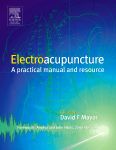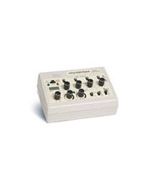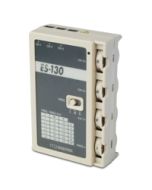We use cookies to make your experience better. To comply with the new e-Privacy directive, we need to ask for your consent to set the cookies. Learn more.
Electroacupuncture: A Practical Manual and Resource
Presents an overview of the theoretical foundations of electroacupuncture, together with experimental and clinical evidence for its efficacy. It also provides guidance on the effective clinical practice of electroacupuncture, illustrated with informative case histories. The accompanying CD-ROM is an ideal research tool, providing searchable chapters from the book as well as an extensive database of more than 8,000 clinical trials that can be accessed via the CD-ROM or through a companion website.
Features
• The first comprehensive overview of modern acupuncture methods for 20 years
• Clear and accessible guide to an increasingly popular form of acupuncture practice
• Designed for both technically and non-technically minded readers
• Provides a basis for immediate practical application in a variety of clinical situations
• Case studies from expert practitioners in the field illustrate the variety of possible approaches
• Only book on the subject to offer both practical suggestions and thorough exploration of the research behind the practice
• Bridges the gap between traditional and modern scientific approaches to acupuncture
• Sifts and sorts what is often confusing or highly technical material into manageable and practical information
• Includes an interactive CD-ROM containing over 15,000 references
• Fully searchable database of more than 8,000 clinical studies is accessible via the accompanying CD-ROM and website
• Includes material from thousands of studies never before available in English - translated from Chinese, Russian, Ukrainian and other European languages
• Database includes material from thousands of studies never before available in English - translated from Chinese, Russian, Ukrainian and other European languages
• Comprehensive glossary defines and explains important concepts
The culmination of a project that has taken a decade to bring to press, David Mayor’s Electroacupuncture is the textbook equivalent of a Swiss army knife - an admirable shot at achieving more things than are possible in the format. This is an unfeasible task, a challenge. Whilst aiming to explain all manner of equipment and the science behind it, he simultaneously attempts to summarise close on ten thousand research papers; and, as we will see, that is only part of it. His target readership is broad too. Mayor aims to appeal to almost every acupuncturist, regardless of outlook, who ever considered connecting their patient to a gizmo. With so much material presented here Electroacupuncture (EA) is more a resource than simply a textbook. Its 400 pages of dense text, the content-rich CD ROM and its web links make EA so boundless that we forgive the flaws. Frankly, if you are at all serious about acupuncture this has to be one of the best bargains ever brought before us.
Mayor’s outlook is eclectic to say the least. Here is such a broad mix of style and content that the average reader is sure to find some parts too scientific and other parts not scientific enough. We get the full range from nuts and bolts rigour at one end, right the way through to technology that would not look out of place in the medical room of the USS Enterprise.
The first quarter of the book, is a short textbook on the relevant science; electrophysics, physiology, neurobiology and electrotherapeutics. This opening section includes two chapters outlining what is known and conjectured about the ways that the electromagnetic spectrum may affect physiology and pathology. The intellectual spectrum too runs between hard science and fringe science but Mayor avoids any critique of either. For better or worse, we get little insight into what Mayor’s personal outlook is.
In style this first section is akin to a science revision guide – concise, if a little dry. If you have a science background it is safe to skim through this part and just cherry pick the more interesting bits. If science is not your strong point you may struggle with some of this material but the science is not really essential to follow the rest of the book. In places I did have that 'too much information' feeling. An example was Mayor’s discussion on nerve conduction injury explaining neurapraxia, axonotmesis and neurotmesis. My first degree was in neurophysiology but I cannot recall encountering these terms and I guess few electro-acupuncturists are going to need them. Almost too much is squeezed between the covers. Mayor next provides a succinct chapter on bioresonance and the development of electrotherapeutics. Noteworthy at this point are the end-of-chapter summaries, the suggested reading lists and the outlines of the extra material to be found on the CDRom.
Next Mayor presents two chapters asking 'how does electroacupuncture work?' This impossible question is addressed by drawing together the otherwise bewildering mass of experimental work on electrotherapeutic responses, endorphin and other neurotransmitter research. The question is, of course, impossible - not for lack of data but because it is misframed. We would struggle in the same way with the question 'how do little white pills work?' In medicine sensible questions are more context specific and more clinically real – 'how can a good acupuncturist accelerate wound healing?' for example Nevertheless it is always fun to see the question attempted.
One way that Mayor tackles this 'how does it work' question is by tabulating the results of numerous Chinese experimental studies. This leads to pages of data along the lines of: “P5 – improves ECG and sino-atrial conduction in acute myocardial infarction when combined with P6,” and, “Liv 8 – may have some useful immunosuppressive effects.”
This is the 'just take a look at all this stuff – there must be something going on!' approach. Obviously, something does happen when you do acupuncture, but today’s critical reader is easily irritated by pages of unreferenced statements and soon asks 'says who?' So your irritable hyper-critical reviewer turns next to the accompanying CDRom. Now we really begin to get an inkling of why Mayor’s project has taken so long; every chapter in the book is repeated here in long form, with extra detail and, crucially, with references galore. Print all this on paper and trees would just be a memory. The CDRom resource is simply peppered with references - thousands of them. Quite apart from the tree issue, their inclusion in the main text would have made for some very messy typography. Clicking on the superscript hyperlinks takes us on to the full reference and many of these then link on to abstracts on disk. In effect what you get is a substantial research library at your fingertips, not only on EA but on general acupuncture too. This is an absolute dream. Especially for those of us who see acupuncture not simply as alternative energy medicine for the credulous but who consider it almost as semi-substantiated as modern biomedicine.
As if easy access to a research abstracts database was not enough, the CDRom also offers numerous internet research resource link, in particular to an associated website: www.electroacupunctureknowledge.com. To put this into context, for the cost of this book and its add-on resources you could buy just a handful of journal article reprints from an academic library.
EA’s importance as a resource is not simply an academic one; it offers the ordinary practitioner a chance to raise their professional game. When asked 'do you think acupuncture can help me?' I like to keep guessing or bluffing to a minimum. EA helps us do this with integrity by making it easier to root our answers in some level of evidence, not simply in our faith in the tradition and in our clinical experience. Much more than just a 'how to do it' book, EA allows us easy access to research and informed expert opinion on numerous areas of our clinical work.
Next we come to the chapter 'Does EA work?' , Dr Adrian White’s pithy contribution to Mayor’s book. Heavyweight doyen of the hyper-rigorous approach, White offers a more critical and guarded interpretation of the literature on EA’s clinical evidence. This chapter is mainly a tabulation of about 70 clinical studies and naturally our eyes are drawn to the outcome section. Glancing down this column the words we see most often are “no difference” and in this way White conveys the impression that benefit from EA was not shown by these studies. He concludes, “On balance, the present evidence from clinical trials does not provide support for the therapeutic value of EA as used in clinical practice.”
We might accept the conclusions of a reviewer of White’s calibre at face value but a closer look reveals some curious distortions. In many of the studies dismissively graded by White as showing 'no difference', EA was compared with standard medical care. Hold on though, 'no difference' did not mean that EA was actually ineffective. Instead these words are used to indicate that the acupuncture was as effective as the drug or other treatment. To cite one example, in the Luo (1985) trial of EA verses Amitryptiline for depression, the EA was as effective as the drug – but without the side effects. It seems misleading to represent this as 'no difference'. In such head-to-head trials in the wider medical world the intervention with the lower adverse event profile would be promoted as the treatment of choice. “Overall,” White reiterates, “the evidence is promising but not sufficient to be able to conclude that EA has significant clinical effects”. It is unclear to me why Mayor let this contribution go unchallenged.
Next up is chapter 9. Running to almost 200 pages, this makes up about half the book and has an entirely different character to what has gone before. It is another book again, a book within a book where Mayor hands over much of the writing to other contributors who provide essays on the clinical applications of acupuncture under specialist headings.
The style differs from most acupuncture texts. More linked to the research and more clinically real, the format is what we might expect from a specialist seminar. Most textbooks suggest we differentiate and treat a condition in a particular way but rarely connect this to the insights that come from the research literature and from specialist practice. The sixteen subchapters here have been contributed by some twenty practitioners with expertise in areas such as neurology, obstetrics, pain, urology, gastroenterology and so on.
The quality of these contributions varies, the gloss on the research is variable and the content could have been better polished and perhaps edited down. We get some random opinions on treatment along the lines of “For vaginal prolapse …. van Nghi recommends EA at ….”. Also detrimental to this section is the habit of failing to attribute advice to any source at all.
These gripes are easily outweighed by the many useful snippets of information difficult to obtain elsewhere. I was delighted to find an excellent short section on the little-discussed pain syndromes that used to be called 'causalgia' – now apparently called 'complex regional pain disorder'.
The final five chapters are closer to what you might have expected from a book on electro-acupuncture. Mayor surveys the types of equipment available and what they are about; electrodes, microwaves, piezo devices, lasers, TENS, ultrasound, point detectors and so on. Here we get some down to earth guidance on what is available. Mayor examines some of the practicalities of EA, including optimal stimulation, types of equipment, choosing a stimulator, and so on. Quite a lot of space is devoted to appraisals of equipment on the market, in effect a buyers guide on what to look for in a basic EA device. From the discussions of basic gear we move on to the more esoteric techno-gizmos; vega, EAV-Voll, Ryodoraku, bioresonance and so on. Inevitably levels of criticality have to drop here. Reference to credible research in the text is scant.
Mayor’s foreword tells us that he was motivated to begin this project by a desire to know what the optimal forms of EA stimulation actually are, what waveforms, frequencies and intensities of stimulation are best for what clinical situations. He is surely not alone in this, so it does seem an odd failing that this key practical information it is quite difficult to get out of the text. It must be in there somewhere, scattered around the oceans of other information, but a more concise presentation of this aspect would not go amiss in a future edition.
To sum up, this is a project on a monumental scale, one that in the cash-soaked world of medibusiness would require multimillion investments and contributions from teams of experts. With this in mind what Mayor has achieved with next to nothing but time, energy and sheer commitment is indeed remarkable. Any flaws in Electroacupuncture have to be set against the dimensions of the task. Mayor has not only organised the evaluation and review of some 8000 research papers and collated masses of information on EA but has also created a multifaceted practitioner resource, the most comprehensive available one yet on the ways that science and technology can support clinical acupuncture. For the sheer breadth of content this is also an absolute bargain. Quite apart from its value to practitioners and researchers we should buy Electroacupuncture if only to reimburse Mayor for his lost decade and to encourage the publishers Churchill-Livingstone-Elsevier to continue to foster this medicine.
Charles Buck
Part 1
Initial Orientation. Introduction. Electroacupuncture East and West: the historical context.
Part 2
Electromagnetism and vibration: concepts and terminology. Electroacupuncture in context: the effects of electrotherapy. Neurophysiology, acupoints and meridians: Western and Eastern perspectives. How electroacupuncture works
I Observations from experimental and animal studies.
II Gathering the threads - from observations to mechanisms and models. Does electroacupuncture work? Evaluating the controlled clinical trials. Acupuncture in clinical practice; an overview, . Psychological and nervous conditions. Stroke and cerebrovascular disease. Peripheral motor disorders. The immune system and the endocrine system. Disorders of the skin and hair., eye and ear, nose, throat and mouth. Obstetrics, gynaecology and the breast. The cardiovascular system. The respiratory system. The gastrointestinal system, liver, gallbladder and pancreas. The genitourinary tract. Pain and its treatment. Neurogenic pain - Head and facial pain - Neck pain. Musculoskeletal conditions: an integrated approach. Acupuncture anaesthesia. Postoperative pain. Addiction. Appetite regulation and weight control.
Part III
Technology and Practice. The technology of acupuncture. Tools of the Trade. Practicalities. The basic do's and don'ts. An integrated approach. Conclusion and the view ahead.
Appendix 1 Resources: information, organizations and suppliers.
Appendix 2 Technology in practice: assessment, legislation and insurance.
| Summary | Features • The first comprehensive overview of modern acupuncture methods for 20 years • Clear and accessible guide to an increasingly popular form of acupuncture practice • Designed for both technically and non-technically minded readers • Provides a basis for immediate practical application in a variety of clinical situations • Case studies from expert practitioners in the field illustrate the variety of possible approaches • Only book on the subject to offer both practical suggestions and thorough exploration of the research behind the practice • Bridges the gap between traditional and modern scientific approaches to acupuncture • Sifts and sorts what is often confusing or highly technical material into manageable and practical information • Includes an interactive CD-ROM containing over 15,000 references • Fully searchable database of more than 8,000 clinical studies is accessible via the accompanying CD-ROM and website • Includes material from thousands of studies never before available in English - translated from Chinese, Russian, Ukrainian and other European languages • Database includes material from thousands of studies never before available in English - translated from Chinese, Russian, Ukrainian and other European languages • Comprehensive glossary defines and explains important concepts |
|---|---|
| Author | David Mayor |
| Publication Date | 7 Apr 1970 |
| Publisher | Churchill Livingstone |
| Number of Pages | 352 |
| Book Format | Softback |
* Orders shipped outside of Europe are eligible for VAT relief and will not be charged VAT.






